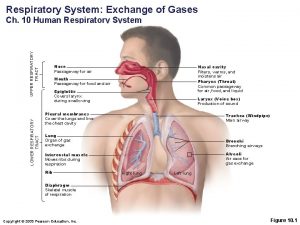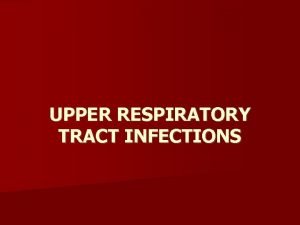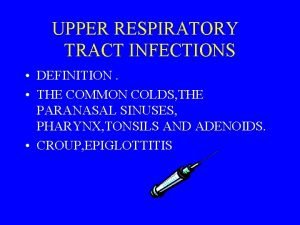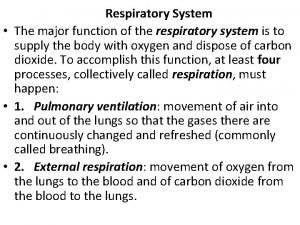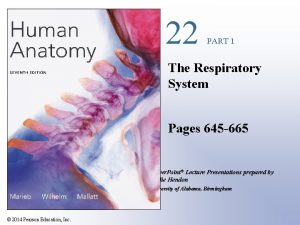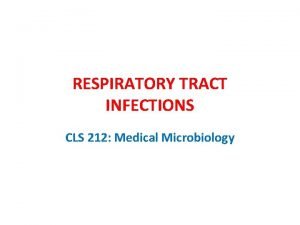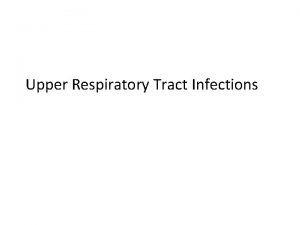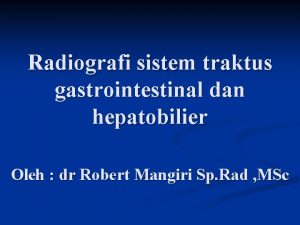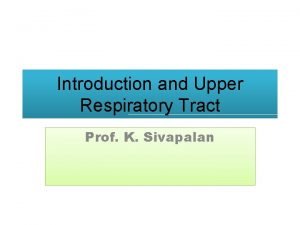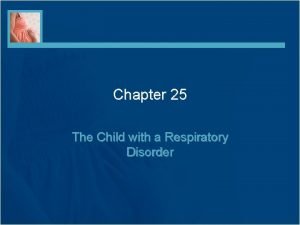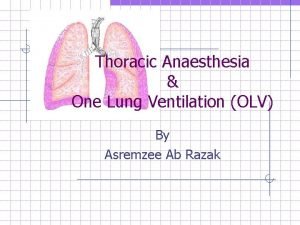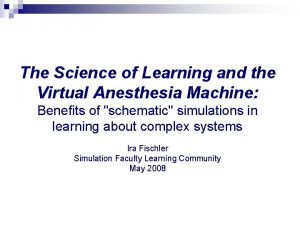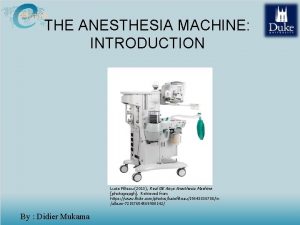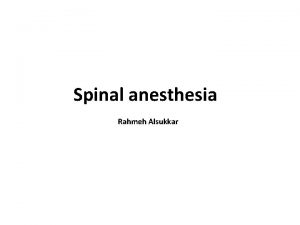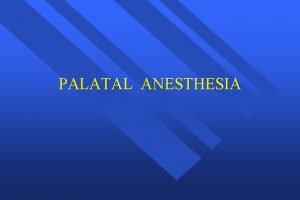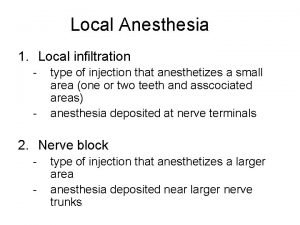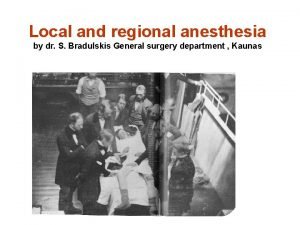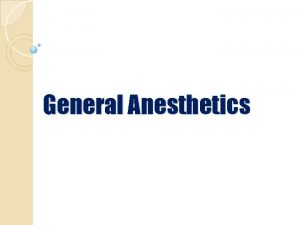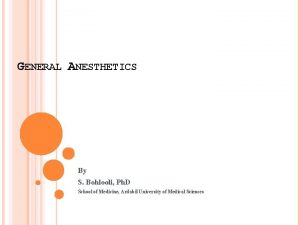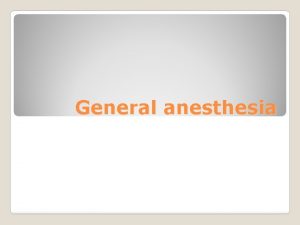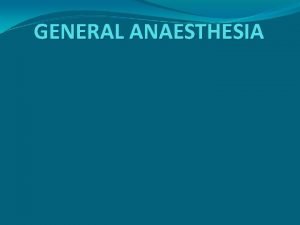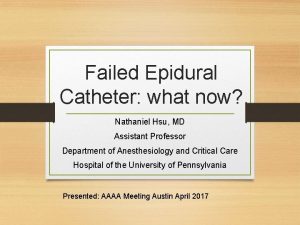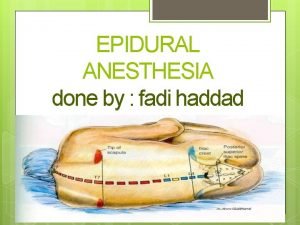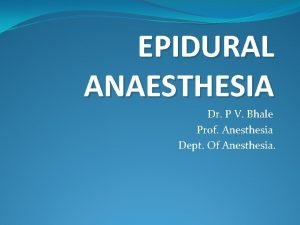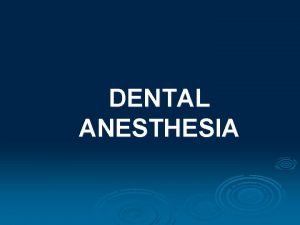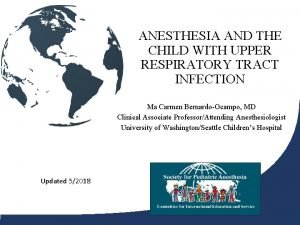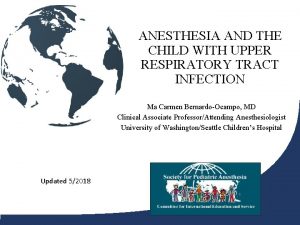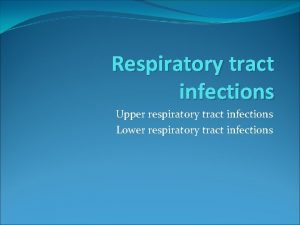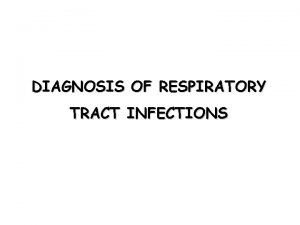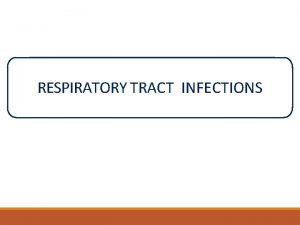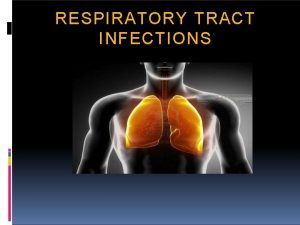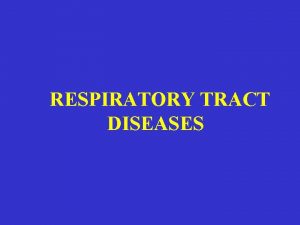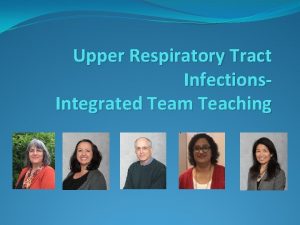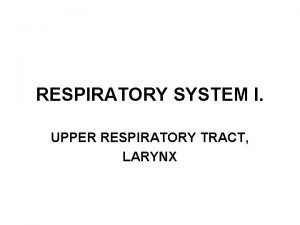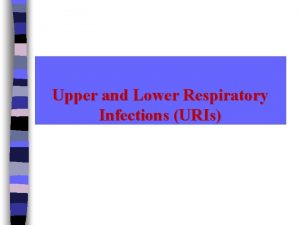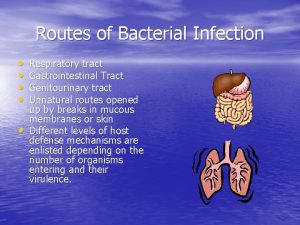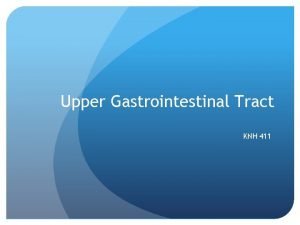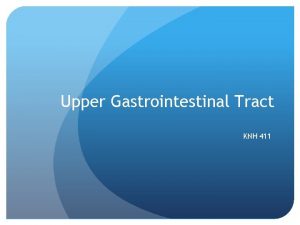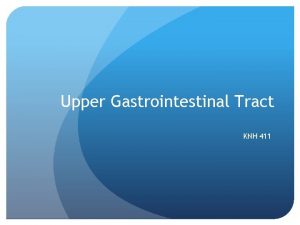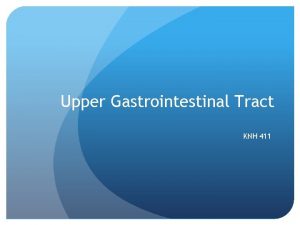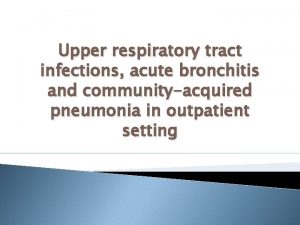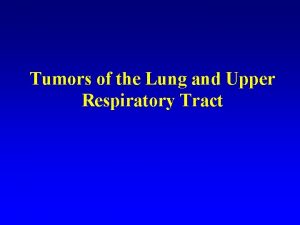ANESTHESIA AND THE CHILD WITH UPPER RESPIRATORY TRACT




















































- Slides: 52

ANESTHESIA AND THE CHILD WITH UPPER RESPIRATORY TRACT INFECTION Ma Carmen Bernardo-Ocampo, MD Clinical Associate Professor/Attending Anesthesiologist University of Washington/Seattle Children’s Hospital

No Disclosure

Objectives 1. Review the etiology and differential diagnoses of upper respiratory tract infection (URI) 2. Discuss the causes of bronchoconstriction in URI 3. Reiterate the adverse respiratory effects of URI 4. Present the current recommendations on the anesthetic management of the child with URI 5. Describe the long-acting muscarinic antagonists currently in development

Introduction

URI is the most common reason for emergency department visits and unscheduled outpatient consultations in the United States. Burt CW, Mc. Caig LF, Rechtsteiner EA. Ambulatory medical care utilization estimates for 2005. Adv Data. 2007; 388: 1 -15.

Most adults in the United States experience 2 to 4 URIs per year, and most children experience 6 to 10 per year. Fendrick AM, Monto AS, Nightengale B, Sarnes M. The economic burden of non-influenza-related viral respiratory tract infection in the United States. Arch Intern Med 2003; 163(4): 487 -494. Bramley TJ, Lerner D, Sarnes M. Productivity losses related to the common cold. J Occup Environ Med 2002; 44(9): 822 -829.

URI and respiratory complications

Etiology • Approximately 200 viruses cause infection that contribute to the clinical syndrome of cough, nasal congestion, nasal discharge, sore throat and sneezing. • Ninety five percent of URIs are secondary to viral causes, with rhinoviruses accounting for 30 -40% Monto AS. Epidemiology of viral respiratory infection. Am J Med 2002; 112(suppl 6 A): 4 S-12 S. Heikkinen T, Jarvinen A. The common cold. Lancet 2003; 361(9351): 51 -59. Tait AR, Malviya S. Anesthesia for the child with an upper respiratory tract infection: still a dilemma? Anesth Analg 2005 Jan; 100(1): 59 -65.

Mechanisms of bronchoconstriction secondary to viral infection Release of inflammatory mediators (bradykinin, PG, histamine, interleukin) Inhibition of M 2 receptors by viral neuraminidases Increase in smooth muscle sensitivity to tachykinins found in the vagal fibers of the airways Tait AR, Malviya S. Anesthesia for the child with an upper respiratory tract infection: still a dilemma? Anesth Analg 2005 Jan; 100(1): 59 -65.

Differential diagnoses • Infectious croup influenza bronchiolitis herpes simplex • Non-infectious allergic pneumonia epiglottitis strep throat vasomotor Tait AR, Malviya S. Anesthesia for the child with an upper respiratory tract infection: still a dilemma? Anesth Analg 2005 Jan; 100(1): 59 -65.

Risk of perioperative respiratory complications • Greatest in the 3 days after a URI but remains increased for up to 6 weeks after • Infrequent residual morbidity despite increased risk in children with URI • Patients recovering from URI have a similar or increased risk compared to those who have acute symptoms Tait AR, Malviya S, Voepel-Lewis T, et al. Risk factors for perioperative adverse respiratory adverse events in children with upper respiratory tract infections. Anesthesiology. 2001 Aug; 95(2): 299 -306.

Adverse respiratory events • Coughing • Laryngospasm • Bronchospasm • Breath holding • Airway obstruction • Desaturation <90% Tait AR, Malviya S, Voepel-Lewis T, et al. Risk factors for perioperative adverse respiratory adverse events in children with upper respiratory tract infections. Anesthesiology. 2001 Aug; 95(2): 299 -306.

Adverse respiratory events • Atelectasis • Post-intubation croup • Pneumonia • Unanticipated tracheal intubation or reintubation Tait AR, Malviya S, Voepel-Lewis T, et al. Risk factors for perioperative adverse respiratory adverse events in children with upper respiratory tract infections. Anesthesiology. 2001 Aug; 95(2): 299 -306.

Risk factors for adverse respiratory events Patient factors • Parent reports child has “cold” • Copious secretions • Presence of nasal congestion • Presence of sputum Tait AR, Malviya S, Voepel-Lewis T, et al. Risk factors for perioperative adverse respiratory adverse events in children with upper respiratory tract infections. Anesthesiology. 2001 Aug; 95(2): 299 -306. Parnis SJ, Barker DS, Van Der Walt JH. Clinical predictors of anesthetic complications in children with upper respiratory tract infections. Pediatr Anaesth 2001 Jan; 11(1): 29 -40.

Risk factors for adverse respiratory events Patient factors • Snoring • Passive smoking • History of reactive airway disease • History of prematurity < 37 weeks Tait AR, Malviya S, Voepel-Lewis T, et al. Risk factors for perioperative adverse respiratory adverse events in children with upper respiratory tract infections. Anesthesiology. 2001 Aug; 95(2): 299 -306. Parnis SJ, Barker DS, Van Der Walt JH. Clinical predictors of anesthetic complications in children with upper respiratory tract infections. Pediatr Anaesth 2001 Jan; 11(1): 29 -40.

Risk factors for adverse respiratory events Anesthesia-related factors • Induction agent used • Thiopental > halothane = sevoflurane > propofol • Airway management • ETT>LMA>FM Tait AR, Malviya S, Voepel-Lewis T, et al. Risk factors for perioperative adverse respiratory adverse events in children with upper respiratory tract infections. Anesthesiology. 2001 Aug; 95(2): 299 -306. Parnis SJ, Barker DS, Van Der Walt JH. Clinical predictors of anesthetic complications in children with upper respiratory tract infections. Pediatr Anaesth 2001 Jan; 11(1): 29 -40.

Risk factors for adverse respiratory events Anesthesia-related factors • Maintenance agent • No difference inhalational vs intravenous • Isoflurane > sevoflurane • Use of muscle relaxants • Not reversed > reversed • Anticholinesterase lowers probability of adverse events Tait AR, Malviya S, Voepel-Lewis T, et al. Risk factors for perioperative adverse respiratory adverse events in children with upper respiratory tract infections. Anesthesiology. 2001 Aug; 95(2): 299 -306. Parnis SJ, Barker DS, Van Der Walt JH. Clinical predictors of anesthetic complications in children with upper respiratory tract infections. Pediatr Anaesth 2001 Jan; 11(1): 29 -40.

Risk factors for adverse respiratory events Surgical factors • Airway surgery • Sudden intense surgical stimulation • Emergency surgery Tait AR, Malviya S, Voepel-Lewis T, et al. Risk factors for perioperative adverse respiratory adverse events in children with upper respiratory tract infections. Anesthesiology. 2001 Aug; 95(2): 299 -306. Parnis SJ, Barker DS, Van Der Walt JH. Clinical predictors of anesthetic complications in children with upper respiratory tract infections. Pediatr Anaesth 2001 Jan; 11(1): 29 -40.

Preanesthetic Evaluation

Preoperative assessment • History • uncomplicated URI • overtly sick • Physical examination • Laboratory examinations • chest radiograph • white blood cell count • nasopharyngeal swabs or aspirates

Laboratory tests • Laboratory tests are available to confirm the diagnosis of URI but they are not cost-effective and may not be practical in a busy surgical setting. • Chest X-ray is done if the physical examination is questionable. Tait AR, Malviya S. Anesthesia for the child with an upper respiratory tract infection: still a dilemma? Anesth Analg 2005 Jan; 100(1): 59 -65.

Suggested Algorithm for Preoperative Assessment of Pediatric Patients with URI Child with URI symptoms Proceed Yes Is surgery urgent? Mild-moderate Other factors to consider: • Age of child • Activity level • Physical examination findings • Reactive airway disease • Exposure to tobacco smoke • Type of surgery • Social and economic factors • Experience and provider comfort in • anesthetizing a child with URI Assess severity of symptoms Severe • • Cancel, reschedule after 4 -6 weeks Assess risk/benefit Proceed with surgery Mucopurulent nasal discharge Productive cough Fever Poor appetite Malaise Lethargic, ill-appearing Rhonchi, wheezing, rales Good No Poor Cancel, reschedule after 2 -4 weeks

Risk/Benefit Assessment Pro • • • Older child Active and happy Good appetite Clear rhinorrhea Clear lungs • Social issues • Short and minor surgery not involving the airway or any major body cavity • Provider comfortable in anesthetizing a child with URI Tait AR, Malviya S. Anesthesia for the child with an upper respiratory tract infection: still a dilemma? Anesth Analg 2005 Jan; 100(1): 59 -65.

Risk/Benefit Assessment Con • • Child < 1 year, ex-premie Fever > 38 C Productive cough Mucopurulent nasal discharge • Malaise, poor appetite • • Irritable, ill-appearing Lethargic Rhonchi, wheezing, rales History of reactive airway disease • Major surgery Tait AR, Malviya S. Anesthesia for the child with an upper respiratory tract infection: still a dilemma? Anesth Analg 2005 Jan; 100(1): 59 -65.

Should surgery be cancelled? • Blanket cancellation avoids complications • But: • increases emotional and economic burdens on parents • not practical in current environment of increasing caseloads and pressures to expedite surgery Coté CJ. The upper respiratory tract infection (URI) dilemma: fear of complication or litigation? Anesthesiology 2001 Aug; 95: 283 -5. Tait AR, Malviya S. Anesthesia for the child with an upper respiratory tract infection: still a dilemma? Anesth Analg 2005 Jan; 100(1): 59 -65.

Anesthetic Management

Anesthetic management Goal is to minimize secretions and avoid/limit stimulation of a potentially sensitive or irritable airway Tait AR, Malviya S. Anesthesia for the child with an upper respiratory tract infection: still a dilemma? Anesth Analg 2005 Jan; 100(1): 59 -65.

Guide to the Anesthetic Management of a Child with URI, Surgery to proceed Optimize child’s condition: Hydration, Humidification Bronchodilator, Suction secretions GA – propofol, sevoflurane ETT: Airway surgery Surgery involving major body cavities Reverse muscle relaxant, if used Bronchodilator Suction oropharyngeal secretions Awake/deep extubation Face mask/LMA, when appropriate: Minor surgery Surgery involving superficial structures Propofol, Sevoflurane + Regional block, Local anesthetic Systemic analgesics Suction oropharyngeal secretions Remove LMA awake/deep

Glycopyrrolate 130 children 1 m-18 y for elective surgery with URI randomized to glycopyrrolate (G) or placebo (P) group No statistical difference in the incidence or severity of perioperative respiratory events no difference in outcome between the 2 groups Tait AR et al. Glycopyrrolate does not reduce the incidence of perioperative adverse event in children with upper respiratory tract infections. Anesth Analg 2007 Feb; 104(2): 265 -70.

Glycopyrrolate • Children in the G group had • more frequent parent-reported complications (dehydration, flushed face, hyperactivity, wheezing, dizziness) • significantly shorter discharge times • significantly less postoperative nausea and vomiting Tait AR et al. Glycopyrrolate does not reduce the incidence of perioperative adverse event in children with upper respiratory tract infections. Anesth Analg 2007 Feb; 104(2): 265 -70.

Glycopyrrolate Conclusion: Glycopyrrolate, administered after induction of anesthesia to children with URIs, does not reduce the incidence of perioperative respiratory adverse events, and thus may not be clinically indicated for routine use in this population. Tait AR et al. Glycopyrrolate does not reduce the incidence of perioperative adverse event in children with upper respiratory tract infections. Anesth Analg 2007 Feb; 104(2): 265 -70.

Bronchodilators/steroids • Administration of combined corticosteroids and salbutamol to adult patients preoperatively was more effective in minimizing intubation-evoked bronchoconstriction compared to inhaled salbutamol alone. Silvanus M-T, Groeben H, Peters J. Corticosteroids and inhaled salbutamol in patients with reversible airway obstruction markedly decrease the incidence of bronchospasm after tracheal intubation. Anesthesiology 2004; 100: 1052 -7.

Airway device Lubrication of the LMA device with lidocaine gel reduces the incidence of airway complications in children with an upper respiratory tract infection. Schebesta K. Guloglu E. Chiari A. et al. Topical lidocaine reduces the risk of perioperative airway complications in children with upper respiratory tract infections. Can J Anaesth. 2010 Aug; 57(8): 745 -50. Epub 2010 Jun 4.

Depth of anesthesia • Adequate depth of anesthesia necessary to obtund the airway reflexes • Use of sevoflurane for induction and maintenance results in fewer complications Tait AR, Malviya S, Voepel-Lewis T, et al. Risk factors for perioperative adverse respiratory events in children with upper respiratory tract infections. Anesthesiology 2001; 95: 299 -306.

Extubation No difference in the incidence of complications when ETT removed awake or under deep anesthesia Tait AR, Malviya S, Voepel-Lewis T, et al. Risk factors for perioperative adverse respiratory events in children with upper respiratory tract infections. Anesthesiology 2001; 95: 299 -306.

Medicolegal aspects “I always make a note in the record that these issues have been discussed with both the surgeon and the family and that everyone has been informed of the risks and has agreed to proceed. ” Charles J Coté, MD Coté CJ. The upper respiratory tract infection (URI) dilemma: fear of complication or litigation? Anesthesiology 2001 Aug; 95: 283 -5.

Recent developments

One of the postulated mechanisms of obstructive lung disease is persistent inflammation of airways. This is attributed to an increased cholinergic tone via the activation of human muscarinic M(3) receptor subtype (h. M(3)) in the airway smooth muscles. Casarosa P et al. Preclinical evaluation of long-acting muscarinic antagonists: comparison of tiotropium and investigational drugs. J Pharmacol Exp Ther 2009 Aug; 330(2): 660 -8. Epub 2009 May 28.

Are there new anticholinergic drugs being investigated that would selectively block the M(3) receptor?

Tiotropium vs other long-acting muscarinic antagonists (LAMAs) Tiotropium bromide, a muscarinic antagonist, used once a day for chronic obstructive pulmonary disease Aclidinium, a novel potent muscarinic antagonist with a fast onset of action, long duration of effect and favorable cardiovascular safety profile Casarosa P et al. Preclinical evaluation of long-acting muscarinic antagonists: comparison of tiotropium and investigational drugs. J Pharmacol Exp Ther 2009 Aug; 330(2): 660 -8. Epub 2009 May 28. Gavalda A et al. Characterization of aclidinium bromide, a novel inhaled muscarinic antagonist. J Pharmacol Exp Ther 2009 Nov; 331(2): 740 -51. Epub 2009 Aug 26.

Tiotropium vs LAMAs affinity/potency of LAMAs [p. A(2) dissociation T 1/2 from h. M 3 (hrs) level of bronchoprotection (%) 27 35 9. 6 10. 7 21 9. 7 6. 1 0 tiotropium 10. 4 aclidinium glycopyrrolate Casarosa P et al. Preclinical evaluation of long-acting muscarinic antagonists: comparison of tiotropium and investigational drugs. J Pharmacol Exp Ther 2009 Aug; 330(2): 660 -8. Epub 2009 May 28.

Tiotropium vs LAMAs Conclusion: Tiotropium provided greater bronchoprotective effect than aclidinium in the dog model after 24 hours and glycopyrrolate did not show any bronchoprotection. Casarosa P et al. Preclinical evaluation of long-acting muscarinic antagonists: comparison of tiotropium and investigational drugs. J Pharmacol Exp Ther 2009 Aug; 330(2): 660 -8. Epub 2009 May 28.

CHF 5407 A novel quarternary ammonium salt that produces a potent, long-acting and selective muscarinic M 3 receptor antagonist effect Showed a prolonged antibronchospastic activity due to its very slow dissociation from M 3 receptors Villetti G et al. Pharmacol Exp Ther. 2010 Aug 30. [Epub ahead of print]

CHF 5407 Markedly short-acting at M 2 receptors, did not produce significant changes in cardiovascular parameters of anesthetized guinea pigs In contrast, tiatropium dissociated slowly from both the M 3 and M 2 receptors. Villetti G et al. Pharmacol Exp Ther. 2010 Aug 30. [Epub ahead of print]

Conclusion

• Children with active and recent URIs are at increased risk of respiratory complications • Awareness and identification of risk factors will guide the anesthesiologist in deciding to proceed with and to tailor the anesthetic to the child’s condition • Selective cancellation of surgery for children with URIs • Informed consent, good clinical judgment and experience are crucial factors in the decision-making process.

“Although the child with a URI still presents a challenge, anesthesiologists are now in a better position to make informed decisions regarding the assessment and management of these children, such that blanket cancellation has now become a thing of the past. ” Alan R Tait AR, Malviya S. Anesthesia for the child with an upper respiratory tract infection: still a dilemma? Anesth Analg 2005 Jan; 100(1): 59 -65

References 1. Burt CW, Mc. Caig LF, Rechtsteiner EA. Ambulatory medical care utilization estimates for 2005. Adv Data. 2007; 388: 1 -15. 2. Fendrick AM, Monto AS, Nightengale B, Sarnes M. The economic burden of non-influenza-related viral respiratory tract infection in the United States. Arch Intern Med 2003; 163(4): 487 -494. 3. Bramley TJ, Lerner D, Sarnes M. Productivity losses related to the common cold. J Occup Environ Med 2002; 44(9): 822829. 4. Monto AS. Epidemiology of viral respiratory infection. Am J Med 2002; 112(suppl 6 A): 4 S-12 S.

References 5. Heikkinen T, Jarvinen A. The common cold. Lancet 2003; 361(9351): 51 -59. 6. Tait AR, Malviya S. Anesthesia for the child with an upper respiratory tract infection: still a dilemma? Anesth Analg 2005 Jan; 100(1): 59 -65. 7. Coté CJ. The upper respiratory tract infection (URI) dilemma: fear of complication or litigation? Anesthesiology 2001 Aug; 95: 283 -5. 8. Tait AR. The anesthetic management of the child with an upper respiratory tract infection. Current Opinion in Anesth 2005 Dec; 18(6): 603 -607.

References 9. Tait AR, Malviya S, Voepel-Lewis T, Munro HM, Seiwert M, Pandit UA. Risk factors for perioperative adverse respiratory events in children with upper respiratory tract infections. Anesthesiology 2001 Aug; 95(2): 299 -306. 10. Parnis SJ, Barker DS, Van Der Walt JH. Clinical predictors of anesthetic complications in children with upper respiratory tract infections. Pediatr Anaesth 2001 Jan; 11(1): 2940. 11. Tait AR et al. Glycopyrrolate does not reduce the incidence of perioperative adverse event in children with upper respiratory tract infections. Anesth Analg 2007 Feb; 104(2): 26570.

References 12. Silvanus M-T, Groeben H, Peters J. Corticosteroids and inhaled salbutamol in patients with reversible airway obstruction markedly decrease the incidence of bronchospasm after tracheal intubation. Anesthesiology 2004; 100: 1052 -7. 13. Schebesta K. Guloglu E. Chiari A. et al. Topical lidocaine reduces the risk of perioperative airway complications in children with upper respiratory tract infections. Can J Anaesth. 2010 Aug; 57(8): 745 -50. Epub 2010 Jun 4. 14. Barnes JP. Muscarinic receptor subtypes in airways. Life Sci 1993; 52(5 -6): 521 -527.

References 15. Casarosa P et al. Preclinical evaluation of long-acting muscarinic antagonists: comparison of tiotropium and investigational drugs. J Pharmacol Exp Ther 2009 Aug; 330(2): 660 -8. Epub 2009 May 28. 16. Gavalda A et al. Characterization of aclidinium bromide, a novel inhaled muscarinic antagonist. J Pharmacol Exp Ther 2009 Nov; 331(2): 740 -51. Epub 2009 Aug 26. 17. Villetti G et al. Bronchodilator Activity of (3 R)-3[[[ (3 -fluorophenyl) [(3, 4, 5 trifluorophenyl)methyl]amino] oxy]carbonyl]-1 -[2 -oxo-2 -(2 thienyl)ethyl]-1 -azoniabicyclo[2. 2. 2]octane bromide (CHF 5407) a Potent, Long-Acting and Selective Muscarinic M 3 Receptor Antagonist. J Pharmacol Exp Ther. 2010 Aug 30. [Epub ahead of print]
 Upper and lower respiratory system
Upper and lower respiratory system Upper lower airway
Upper lower airway Classification of upper respiratory tract infection
Classification of upper respiratory tract infection Anatomy of the upper respiratory tract
Anatomy of the upper respiratory tract Ethmoditis
Ethmoditis Upper respiratory tract
Upper respiratory tract What is the major function of the respiratory system
What is the major function of the respiratory system Respiratory system nasal cavity
Respiratory system nasal cavity Pyramidal vs extrapyramidal
Pyramidal vs extrapyramidal Anterior spinothalamic tract
Anterior spinothalamic tract Air passage
Air passage Classification of pneumonia
Classification of pneumonia Lrti
Lrti Normal flora of respiratory tract
Normal flora of respiratory tract Chassard lapine
Chassard lapine Respiratory zone of the respiratory system
Respiratory zone of the respiratory system Acute upper respiratory infection unspecified คือ
Acute upper respiratory infection unspecified คือ The child with a respiratory disorder chapter 25
The child with a respiratory disorder chapter 25 패자트리
패자트리 Hình ảnh bộ gõ cơ thể búng tay
Hình ảnh bộ gõ cơ thể búng tay Double lumen tube sizing
Double lumen tube sizing Virtual anesthesia machine
Virtual anesthesia machine Fail safe valve anesthesia
Fail safe valve anesthesia Hanger yoke assembly
Hanger yoke assembly Taylor's approach spinal
Taylor's approach spinal Pre anesthesia assessment form
Pre anesthesia assessment form Palatine block
Palatine block Bổ thể
Bổ thể Trigeminal
Trigeminal Tỉ lệ cơ thể trẻ em
Tỉ lệ cơ thể trẻ em Gấu đi như thế nào
Gấu đi như thế nào Mechanism of local anesthesia
Mechanism of local anesthesia Mechanism of local anesthesia
Mechanism of local anesthesia Asa psa msa
Asa psa msa Bier
Bier Mechanism of local anesthesia
Mechanism of local anesthesia Tư thế worm breton là gì
Tư thế worm breton là gì Types of laryngoscope
Types of laryngoscope Mac anesthesia minimum alveolar concentration
Mac anesthesia minimum alveolar concentration Inhalation anesthetics
Inhalation anesthetics Hát lên người ơi alleluia
Hát lên người ơi alleluia Các môn thể thao bắt đầu bằng tiếng chạy
Các môn thể thao bắt đầu bằng tiếng chạy Vrg
Vrg Classification of inhalational agents
Classification of inhalational agents Classification of inhalational agents
Classification of inhalational agents General anesthesia drugs dosage
General anesthesia drugs dosage Cheap diazepam
Cheap diazepam Classification of inhalational agents
Classification of inhalational agents Spinal anesthesia level chart
Spinal anesthesia level chart Epidural anesthesia
Epidural anesthesia Tuohy needle sizes
Tuohy needle sizes Psa block
Psa block
